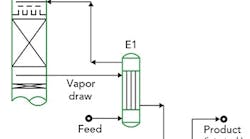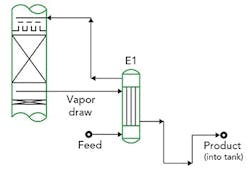[pullquote]
Many problems afflicted a distillation column with a somewhat uncommon configuration — its main product came from a vapor side-draw (see Figure 1). One major difficulty was controlling the column’s side-product purity. The vapor draw was condensed against the column’s feed, which came from tankage and was highly subcooled. Ample surface area in the side condenser ensured that all the vapor could be condensed. A seal-leg in the drain line from the exchanger to the product tank prevented backflow.
Figure 1. Configuration lacks a way to control the vapor rate in the side-draw.
However, what’s missing is any way to control the vapor rate in the side-draw. Flow splits between the side-draw and the main column based upon the pressure balance in the condenser versus the main column. If the condenser is sufficiently oversized, it may get nearly all the vapor. Here, the condenser was vastly oversized. So, little vapor remained in the column, making it impossible to achieve the necessary liquid/vapor ratio for the required product purity.
Additionally, the column must mass balance. If the column feed contains only 5,000 lb/hr of the desired product and the condenser pulls in 6,000 lb/hr of vapor, the reflux ratio in the main column doesn’t matter; product purity never can exceed 83 wt % (i.e., 5,000/6,000).
Any method to control the side-draw vapor rate must vary the pressure balance between the main column and the side-draw — even if the pressure in the exchanger never is measured. Here, this requires modifying the pressure in the condensing space inside exchanger E1’s shell.
The control options are the same as for pressure control of a tower overhead system with no vapor product. The condensing duty must vary. The basic methods are either to manipulate the heat-transfer coefficient or the temperature approach. Many methods do both.
Here, the simplest methods are to put a control valve on the vapor flow to the condenser or one on the liquid flow from the condenser.
A valve in the vapor draw line gives direct control of the flow to the condenser. The condenser pressure will drop to whatever value is required for the condensation temperature to reduce the exchanger’s log-mean temperature difference enough so the product condensation duty equals the feed preheat duty achieved. As the valve closes, the higher differential pressure (DP) between the tower and the exchanger decreases flow rate. Additionally, the pressure in the exchanger drops, further increasing the DP between the tower and exchanger (and the valve closes some more).
The valve in the vapor line inherently has a non-linear physical response. Also, vapor service demands a comparatively large valve. The vertical exchanger in this unit also requires installing the valve at a high elevation.
In comparison, putting the valve in the product outlet line decreases duty by partially flooding the exchanger with subcooling liquid. The liquid-filled region has a lower heat-transfer coefficient as well as a reduced temperature difference due to subcooling. However, the change in area in condensing service versus subcooling service nearly always dominates. So, duty response is almost completely linear with liquid level. Additionally, the control valve is smaller and usually can be installed at grade or another convenient location.
For this unit, installing the control valve in the liquid product line may pose one significant problem — thermal stress on the heat exchanger. As the liquid level alters in the exchanger, tubes change temperature, which can create thermal stresses. Depending upon exchanger materials, temperatures, configuration and fabrication standards, this may or may not be a problem.
Here, we chose the liquid product outlet line as the control valve location. There were some concerns about thermal stress on the exchanger because it had fixed tube-sheets. Nevertheless, the benefits outweighed the potential problem.
Vapor draws are relatively uncommon on distillation towers — so, not that many people understand how to control them. A good approach is to consider how an equivalent pressure control system on the overhead work would function. Keeping this in mind will reduce the risk of having a tower that does not work.


